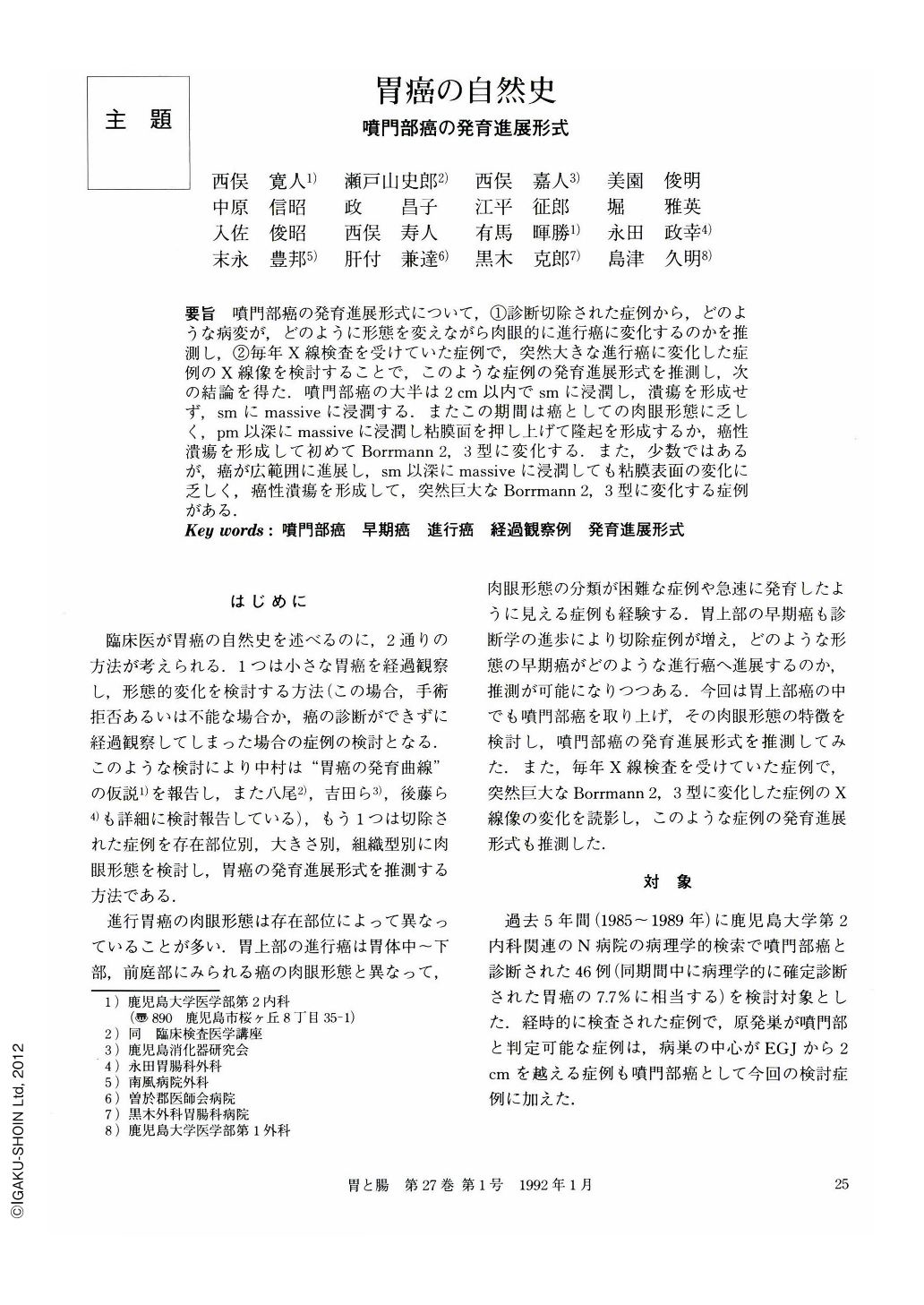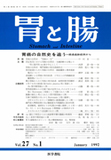Japanese
English
- 有料閲覧
- Abstract 文献概要
- 1ページ目 Look Inside
- サイト内被引用 Cited by
要旨 噴門部癌の発育進展形式について,①診断切除された症例から,どのような病変が,どのように形態を変えながら肉眼的に進行癌に変化するのかを推測し,②毎年X線検査を受けていた症例で,突然大きな進行癌に変化した症例のX線像を検討することで,このような症例の発育進展形式を推測し,次の結論を得た.噴門部癌の大半は2cm以内でsmに浸潤し,潰瘍を形成せず,smにmassiveに浸潤する.またこの期間は癌としての肉眼形態に乏しく,pm以深にmassiveに浸潤し粘膜面を押し上げて隆起を形成するか,癌性潰瘍を形成して初めてBorrmann2,3型に変化する.また,少数ではあるが,癌が広範囲に進展し,sm以深にmassiveに浸潤しても粘膜表面の変化に乏しく,癌性潰瘍を形成して,突然巨大なBorrmann2,3型に変化する症例がある.
(1) The mode of growth/development of cardiac cancer was estimated in 46 cases of cardiac cancer which were diagnosed and resected in the past 5 years, and in which pathological examination was done thoroughly. Furthermore, x-ray patterns of cases which underwent x-ray examination every year, and which, after several years, suddenly showed a morphological change to Borrmann 2, 3 type cancer, and the mode of growth/development of such lesions were studied.
(2) Forty six cases of cardiac cancer were broken down to differentiated cancer 28 cases { early cancer, 26 cases (elevated type, 4 cases, depressed type, 22 cases), advanced cancer, 2 cases } and undifferentiated cancer 18 cases (early cancer, 10 cases, advanced cancer, 8 cases).
(3) As for differentiated cancer, cases measuring 2 cm or less accounted for 82% (23/28). The rate of invasion beyond submucosal layer was 29% (8/28) in the cases of 2 cm or less and 28% (3/11) in the cases of 1 cm or less. The proportion of cases complicated with ulcers was markedly low at 3.5% (1/28).
(4) As for undifferentiated cancer, cases measuring 4.1 cm or more accounted for 72% (13/18) and the rate of invasion beyond submucosal layer in those cases was 85% (11/13). The proportion of cases complicated with ulcers was markedly low at 17% (13/18). The possibility of clinically diagnosing undifferentiated cancer was so low that we were unable to study the mode of growth/development.
(5) Cardiac cancer is liable to invade beyond submucosal layer when it is small in size and presents scarcely any macroscopic morphology even when there is massive invasion beyond submucosal layer. So, it is possible that this cancer massively invades beyond submucosal layer, forms a cancerous ulcer at the site of invasion and develops into Borrmann 2, 3 type. Small though the number was, there were some cases in which cancers showing extensive lesion but less irregularity on the surface of the mucous membrane, invade beyond submucosal layer massively, formed cancerous ulcers suddenly, and developed into giant Borrmann type 2, 3 cancer.

Copyright © 1992, Igaku-Shoin Ltd. All rights reserved.


